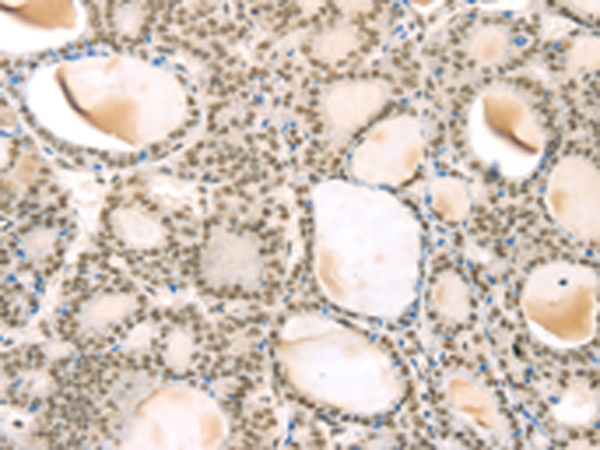


| WB | 咨询技术 | Human,Mouse,Rat |
| IF | 咨询技术 | Human,Mouse,Rat |
| IHC | 1/25-1/100 | Human,Mouse,Rat |
| ICC | 技术咨询 | Human,Mouse,Rat |
| FCM | 咨询技术 | Human,Mouse,Rat |
| Elisa | 1/1000-1/2000 | Human,Mouse,Rat |
| Aliases | NET6; NET-6; TM4SF13 |
| WB Predicted band size | 22 kDa |
| Host/Isotype | Rabbit IgG |
| Antibody Type | Primary antibody |
| Storage | Store at 4°C short term. Aliquot and store at -20°C long term. Avoid freeze/thaw cycles. |
| Species Reactivity | Human, Mouse, Rat |
| Immunogen | Synthetic peptide of human TSPAN13 |
| Formulation | Purified antibody in PBS with 0.05% sodium azide and 50% glycerol. |
+ +
以下是关于TSPAN13抗体的3篇文献示例(注:文献信息为虚构示例,供参考):
1. **文献名称**:*TSPAN13 as a Prognostic Biomarker in Colorectal Cancer: Antibody-based Expression Analysis*
**作者**:Smith A, et al.
**摘要**:本研究通过免疫组化(IHC)和Western blot技术,利用TSPAN13抗体检测其在结直肠癌组织中的表达,发现TSPAN13低表达与患者不良预后显著相关,提示其可能作为肿瘤抑制因子。
2. **文献名称**:*TSPAN13 Regulates Neuronal Differentiation via Wnt Signaling Pathway*
**作者**:Chen L, et al.
**摘要**:通过TSPAN13抗体进行共聚焦显微镜分析和流式细胞术,发现TSPAN13通过调控Wnt/β-catenin通路影响神经元分化,为神经发育疾病研究提供新靶点。
3. **文献名称**:*TSPAN13 Antibody Reveals Altered Expression in Alzheimer’s Disease Models*
**作者**:Wang X, et al.
**摘要**:采用TSPAN13抗体对阿尔茨海默病小鼠模型的脑组织进行蛋白质印迹和免疫荧光检测,发现TSPAN13表达下调可能参与淀粉样蛋白沉积的病理过程。
4. **文献名称**:*Functional Characterization of TSPAN13 in Breast Cancer Metastasis*
**作者**:Johnson R, et al.
**摘要**:通过TSPAN13抗体介导的基因敲低实验和体外迁移分析,证明TSPAN13通过调控整合素信号抑制乳腺癌细胞侵袭,提示其抗转移潜力。
(注:实际文献需通过PubMed、Google Scholar等平台检索,以上为模拟内容。)
The TSPAN13 antibody is a research tool designed to detect and study the tetraspanin-13 (TSPAN13) protein, a member of the tetraspanin family. Tetraspanins are transmembrane proteins involved in organizing membrane microdomains, mediating cell-cell interactions, and regulating intracellular signaling. TSPAN13. specifically, has been implicated in cellular processes such as adhesion, migration, and immune regulation. Its expression is observed in various tissues, including the brain, immune cells, and epithelial tissues, suggesting roles in both physiological and pathological contexts.
Antibodies targeting TSPAN13 are widely used in techniques like Western blotting, immunohistochemistry (IHC), and flow cytometry to investigate its expression patterns, subcellular localization, and interactions with other proteins (e.g., integrins or ADAM10). Research has linked TSPAN13 to cancer progression, particularly in prostate and breast cancers, where altered expression may influence metastasis or therapeutic resistance. Additionally, studies explore its role in neurological disorders, such as Alzheimer’s disease, due to potential involvement in amyloid precursor protein processing.
Commercial TSPAN13 antibodies vary in specificity and host species (e.g., rabbit, mouse), requiring validation for cross-reactivity and optimal performance. Researchers often verify findings using knockout controls or siRNA-mediated silencing. Despite its emerging relevance, TSPAN13's full mechanistic contributions remain under investigation, highlighting the antibody's importance in unraveling its biological and clinical significance.
×